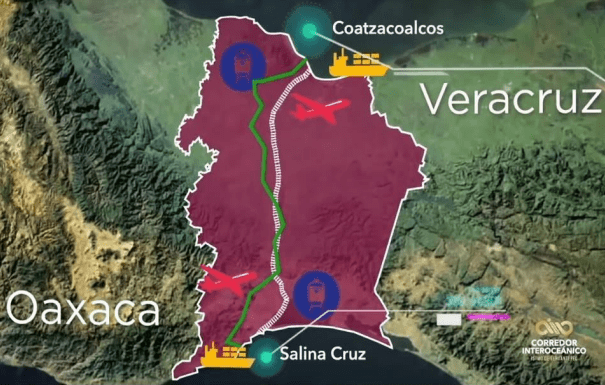The Interoceanic Corridor of the Isthmus of Tehuantepec (CIIT) of Mexico will consist of several modes of transport and an investment of 8,000 million pesos, in part for the rehabilitation of railways for cargo and passengers, the expansion of the Salina Cruz-Coatzacoalcos highway and the expansion and modernization of the ports of Salina Cruz and Coatzacoalcos and the refineries of Salina Cruz and Minatitlán.
The Tehuantepec Isthmus Development Plan includes a planned gas pipeline to supply national companies and consumers.
Throughout CIIT, economic zones will be created to attract private sector investment along with a guarantee of the supply of energy, water, digital connectivity and other basic inputs to meet the needs of businesses and the working population.
As part of the National Development Plan, in 2019, the Government initiated the Isthmus of Tehuantepec Development Plan.
CIIT
For its part, the Isthmus of Tehuantepec Development Plan includes the Interoceanic Corridor of the Isthmus of Tehuantepec, which was created on June 14, 2019 and is expected to start operating at the end of the president’s term.
The CIIT was created in order to implement a logistics platform that integrates the provision of port administration services carried out by the competent entities in the Ports of Coatzacoalcos, Veracruz de Ignacio de la Llave and Salina Cruz, Oaxaca and their interconnection by rail transport , as well as any other action that allows to contribute to the development of the region of the Isthmus of Tehuantepec, with a comprehensive, sustainable, sustainable and inclusive vision, promoting economic, productive and cultural growth
Companies
The CIIT project seeks to modernize the railroad tracks of the isthmus, to reduce travel times.
The participating companies are Ferro Maz, Comsa, Construcciones Urales in conjunction with Regiomontana de Construcción y Servicios, La Peninsular Compañía Constructora, in consortium with Caltia and Grupo SEF.
The Isthmus of Tehuantepec is the narrowest portion of Mexico and North America in general, separating the Pacific Ocean from the waters of the Gulf of Mexico and the Atlantic Ocean.
According to the United States Department of Commerce, Spanish efforts to make this an interoceanic trade route date back to the early 1800s, and a rail line across the Isthmus operated profitably between 1907 and the opening of the Panama Canal in 1914.
Now the López Obrador Administration intends to make the Trans-Isthmus route competitive with the Canal, thus promoting regional economic growth in the states of Oaxaca and Veracruz.
The Trans-Istmo project will create a modernized and improved Multimodal Interoceanic Corridor that will provide an alternative to the Canal for northbound and Post-Panamax shipping.
Logistics
As part of this project, the Mexican Government seeks to modernize the Isthmus of Tehuantepec railway; expand cargo handling and storage capacity in the ports of Coatzacoalcos, Veracruz and Salina Cruz, Oaxaca; expand the highway from two to four lanes; improve the Minatitlán and Ixtepec airports; establish a fiber optic telecommunications connection and cellular / data connectivity; and build a gas pipeline for commercial and private use.
Along the route between the two oceans, 10 development poles will be created to attract investment from the private sector. As part of this program, the 76 municipalities of Oaxaca and Veracruz involved will reduce their value added tax (VAT) and income tax rates, in addition to offering oil at reduced prices.
In March 2021, President López Obrador announced that the Secretary of the Navy (Semar), together with the governments of the states of Veracruz, Oaxaca, Tabasco and Chiapas, will be responsible for managing this corridor once the project is completed.
![]()

